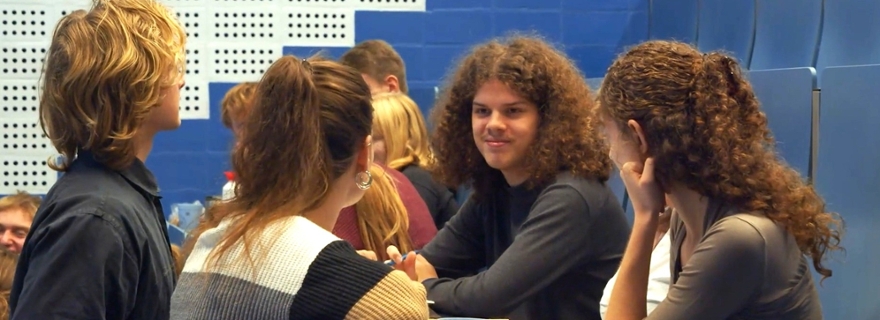
'With dialogue you can create connection among students'
Lectures that focus on dialogue among students can increase their well-being. Lecturers Karin Nijenhuis and Thijs Witty are organising a symposium and teacher professionalisation course on this method of working.
'Things have not been going so well with student wellbeing for some time,' Nijenhuis says of the reason for the symposium and course. 'Especially since the corona period, we see that students are often not feeling great about themselves. I myself was trained as a dialogue trainer and knew that dialogue leads to connection with the people you are in a dialogue group with. I thought it would be useful to apply that principle in education.'
This resulted in a Comenius Senior Fellowship on integrating dialogue in education at the Faculty of Humanities and the African Studies Centre Leiden, which Nijenhuis uses to connect with the university's 2023 Vision on Student Wellbeing. 'The dialogue we use within the Comenius Project is based on the theory of philosopher and quantum physicist David Bohm,' she says. 'This form of dialogue is a very attentive way of talking to each other around one or at most two questions, while keeping to a number of rules. For example, you’re not allowed to interrupt each other. As a result, even the quieter members of a group are heard.'
Applying dialogue in education
Due to the selected cookie settings, we cannot show this video here.
Watch the video on the original website orUse in lecture
In the professionalisation course, Nijenhuis teaches her fellow lecturers more about this approach. University lecturer Thijs Witty took part in the first series and will now teach as a dialogue trainer himself. 'For a while I had been looking for a way to teach that would create more openness in my groups,' he says. 'As a university, we often teach students only a limited way of listening. They generally have to summarise what the lecturer has told them or convince each other with arguments. By using Bohm's dialogue, I soon noticed that students were more inclined to listen to each other's viewpoint, while at the same time becoming more aware of their own role in the conversation, and realizing that what you say affects another person.'
Witty has since tested the dialogue format in several ways in his lectures. 'The first time, I was lucky enough to devote a whole hour to dialogue, and that was eight times in total over a whole year. In contrast, in another subject, I had a one-and-a-half-hour study group in which I also had to impart a lot of knowledge. Then I used a shorter version of the dialogue, with only questioning. Even that proved to be a meaningful addition to the lesson.'
'The full dialogue is indeed time-consuming,' says Nijenhuis. 'Moreover, older research shows that dialogue only affects connectedness if you use this form at least eight to ten times. So you need to think carefully about what you are using the dialogue for: if you want to convey factual knowledge, this form is less suitable. If you want students to reflect on the material or deal with a sensitive topic, on the other hand, it can be a godsend, just like when you put more effort into cross-disciplinary skills such as analysis, cooperation, oral communication and resilience.'
The ‘The power of dialogue in education’ symposium will take place on 20 November. For those who want to go deeper into the method, there is the ‘Dialogue in education’ professionalisation course, which in five sessions looks at ways to use this method in your own teaching. The first session will take place on 2 December.
